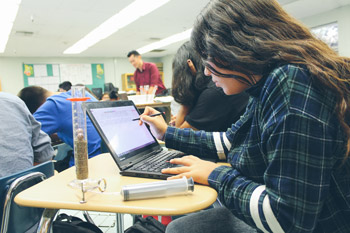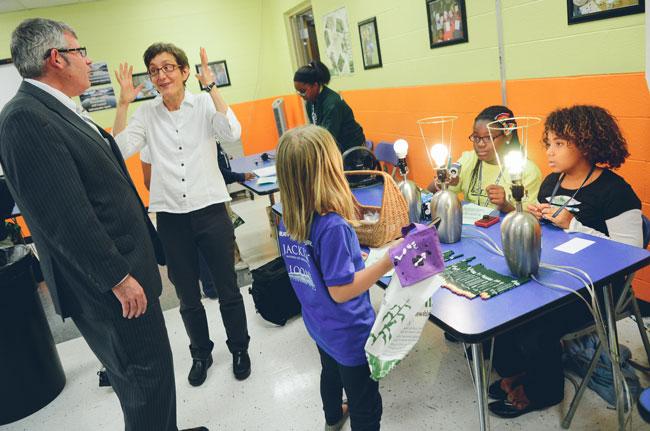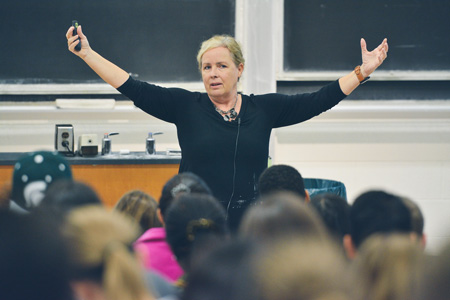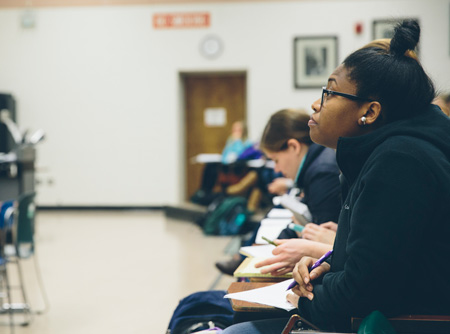
Joe Krajcik,
Lappan-Phillips Professor
of Science Education
MSU scholars unlock the secrets of science teaching to engage the next generation
By Nicole Geary

Los Angeles high school chemistry teacher Michael Lim is piloting a new curriculum developed by MSU researcher Joe Krajcik and team.
Michael Lim was disheartened every year.
Many students were unable to grasp the first concepts of atomic theory introduced in his chemistry class. And when they moved, quickly, to the next topics in the textbook, it was too late. Not only did they have questions about the subject matter—they wondered why they should bother learning it.
“I really wanted to rescue my students, or at least give them the tools so they can survive and thrive on their own,” said Lim. He teaches in the Los Angeles Unified School District where, like many places, a high percentage of students qualify for free lunch and often don’t have a strong foundation of science knowledge by the time they reach high school.
Lim had heard about the new science teaching standards beginning to take hold across the nation. So last summer, he jumped at the chance to try something different.
“I was introduced to this new curriculum from Michigan State, and life has never been the same,” he said.
Lim is one of 15 teachers in California and Michigan piloting Interactions, a three-unit physical science curriculum that is project-based. Rather than giving students information, teachers encourage students to reach their own understanding about phenomena in the world by exploring driving questions. The first, for example, is “Why do some things stick together and others don’t?”

The Interactions digital curriculum helps students learn physical science concepts by encouraging them to explore driving questions together.
Now, rather than tuning out, Lim’s students are leading themselves to find answers through experiments, discussions and written responses, using evidence to support claims. And that dreaded question, ‘why are we learning this?’ “They never asked it one time this semester,” he says.
Developed by a team led by Joe Krajcik, one of the world’s leading experts on science education, the curriculum is one of the first available to help students master some of the core disciplinary ideas and scientific practices outlined in the Next Generation Science Standards (NGSS).
Interactions is among many innovative programs and resources being created by Krajcik and other scholars in the Michigan State University College of Education. Their cutting-edge research is intended to pinpoint the ingredients that truly engage students, from pre-K through college, in what they are learning about science.
How will educators prepare American children to compete in a world that increasingly demands advanced math and science knowledge? The MSU researchers say we can’t answer that question without answering another: how to get students excited about learning the subjects in the first place.
Krajcik and Barbara Schneider, a pre-eminent scholar of sociology in education, recently teamed up to tackle that question. They are collaborating on a teaching experiment in partnership with Finland that will develop high school science materials to promote optimal learning environments (see next section). Another project, funded by Lucas Educational Research, will integrate the learning of science with English language arts and mathematics in elementary schools through project-based learning.
Educators should not be expected to turn every child into a scientist, they say, but fast-changing issues such as global warming, genomics and alternative energy have made it more important than ever for every citizen to gain a higher level of scientific literacy.
Researchers say the so-called three-dimensional approach spelled out by NGSS—focused on learning disciplinary core ideas, crosscutting concepts, and scientific and engineering practices—has the power to better engage and prepare future generations. However, the states, including Michigan, that have now adopted NGSS or standards modeled after NGSS are just beginning to seek out the curriculum, assessments and professional development needed to make that vision a reality.
“It’s this notion of creating environments where kids are actually making use of knowledge rather than having knowledge presented to them,” said Krajcik. “And MSU has an amazing collection of people working on that.”
 From research to reality: The ideal learning environment
From research to reality: The ideal learning environment
Krajcik is director of the CREATE for STEM Institute, a research center at MSU focused on improving teaching and learning in the STEM disciplines (science, technology, engineering and mathematics). The institute is a joint venture of the College of Education and the College of Natural Science, bringing together researchers from many parts of campus with educators in the field.
Projects affiliated with CREATE for STEM total more than $15 million in active research funding and address many of the most pressing challenges at stake to take STEM to the next level, both in K-12 and undergraduate education.
Michigan school districts are collaborating, for example, to support students in building dynamic models of the carbon cycle, develop a middle-school genomics curriculum and create classroom chemistry assessments that align with NGSS.
Educational leaders are paying attention.
“We are looking for ways to really help teachers understand how to teach science in a three-dimensional way—which is totally new. You can’t just take the new standards and teach them the same way,” said Alycia Meriweather, executive director of the Detroit Public Schools Office of Curriculum and director of the Detroit Mathematics and Science Center. A former teacher, she previously worked with Krajcik to pilot the IQWST (Investigating and Questioning our World Through Science and Technology) curricula now available for grades 6 through 8.
“What the university brings to the table is research-based best practices. I’m looking for ways to help my teachers grow, which ultimately helps students learn.”

Barbara Schneider
It is clear that simply knowing content does not predict high achievement or a desire to pursue science, says Krajcik, Lappan-Phillips Professor of Science Education. “Knowing content is important, but knowing how to use that knowledge is more important,” he says.
Even students in Finland, who outperform most of the world on international tests, do not report greater levels of interest in science, or in pursuing scientific careers.
That’s why researchers there are partnering with the MSU team to test whether teaching strategies modeled after project-based learning and NGSS contribute to more engaging classroom learning environments in both the U.S. and Finnish education systems. The $3.6 million project is the first ever focused on education research to receive funding from the National Science Foundation’s Partnerships for International Research and Education (PIRE) program, competing with a wide range of scientific experiments around the world.

Screenshot of app being used in the PIRE grant.
Over the five-year project, researchers will work with teachers to design and implement project-based units in up to 40 high school physics and chemistry classrooms. Building on previous work led by Schneider, the team will also use smartphones to collect real-time data from students using the Experience Sampling Method (ESM). The system prompts students to answer questions on the phones (see photo example) about their experiences from social and emotional, as well as academic, perspectives.
Educators need to get young people interested in the subject matter, but that’s not enough, says Schneider, John A. Hannah Chair and University Distinguished Professor. Students need to know why scientific content is relevant in their world. They also must be challenged by it and believe they can understand it.
In her pilot work with researchers at Finland’s University of Helsinki, she and colleagues found that over the course of a two-week science unit designed to increase engagement, participating students reported experiencing more—the equivalent of a full extra day—of what they call optimal learning moments (OLMs).
“What you do and how you learn matters; it’s not passive,” said Schneider. “Kids vary in how they feel during the school day, and some learning experiences are more engaging than others. We want to build a model where we can maximize those opportunities.”
Motivation and identity: Breaking down barriers
Many MSU researchers are studying science engagement by digging into elements of NGSS or exploring factors that discourage under-represented student groups from succeeding in science classes and careers.
Jennifer Schmidt, who joined the faculty in educational psychology this academic year, also uses ESM to study how school science “feels” and the resulting impact on adolescents. Her previous work at Northern Illinois University, called Science in the Moment (SciMo), found that middle school science teachers addressed male students about 40 percent more often than females. The research also showed that, when faced with a challenging question or task in class, boys were more likely to engage.
“Teachers have asked, ‘Why are we still talking about gender?’” Schmidt said. “Well, if learning about science feels systematically different for males and females over time, this may help explain why women are still less likely to continue to advanced levels.

Professor Angela Calabrese Barton is focused on empowering urban youth to use science in their lives through innovative programs like GET City, a partnership with Boys and Girls Clubs.
“What we find is that, despite achievement evidence that they are performing as well as or better than their male peers, females tend to back away from challenges in science rather than stepping up their game. This is likely due to a combination of their self-perceptions and the messages they get from teachers.”
Schmidt and co-author Lee Shumow compiled their findings into a book of strategies for teachers, “Enhancing Adolescents’ Motivation for Science,” published by Corwin in 2014. She has tested interventions to influence positive mindsets for students and recently expanded the work to summer out-of-school programs.
Colleague Angela Calabrese Barton, a professor of teacher education, has won multiple awards for the long-standing out-of-school program she developed to engage urban youth. Green Energy Technology in the City (GET City), based at the Boys and Girls Clubs in Lansing, Mich., and Greensboro, N.C., gets students excited about learning science by empowering them to act as change agents in their own communities. One NSF-funded project from the Invincibility Lab, her research group, had students creating inventions like an eco-friendly light-up football and an anti-bullying smartphone app.
Calabrese Barton encourages participants to solve problems at play in their own lives using engineering, which is now gaining emphasis in K-12 schools with the NGSS focus on learning science practices. Next, she will explore how the ‘maker’ movement could help shrink the STEM interest gap for under-represented students. As a W.T. Grant Distinguished Fellow, she will spend a year embedded in maker spaces at the Exploratorium in San Francisco and the Impression 5 Science Center in Lansing.
“The pathways into science are so complex, and I am interested in anything we can do to demystify and break down barriers for youth,” said Calabrese Barton, who is also outgoing editor, with Krajcik, of the Journal for Research in Science Teaching.

Melanie Cooper, also a lead writer of the Next Generation Science Standards, has been leading efforts to transform gateway science courses at MSU. Photo credit: Harley J. Seeley Photography
College STEM: Opening the gateway
Fostering success in STEM is no less important in the nation’s colleges and universities.
The new K-12 teaching strategies are starting to make their way into the higher education arena. And, arguably, no other institution is experimenting with this more than MSU.
Michigan State was one of eight sites selected by the Association of American Universities (AAU) to participate in a national project focused on improving undergraduate education in the STEM disciplines. Rather than relying on individual faculty members to influence change, the Undergraduate STEM Education Initiative—overseen by MSU College of Education alumna Emily Miller, Ph.D. ’11 (Higher, Adult and Lifelong Education), as the AAU program officer—supports more systemic efforts.
At MSU, a large contingent of faculty across disciplines has been working together to transform the university’s so-called “gateway” courses in physics, biology and chemistry by rethinking which core concepts to teach as students progress. They are three years into the project led by renowned science education scholar Melanie Cooper—and it’s making a difference for students.
Brittany Lane is one of them. Originally from Muskegon, Mich., she realized not long after arriving at MSU that her high school experiences had not fully prepared her for college-level courses, especially in mathematics and science. The aspiring dermatologist nearly changed her future plans when she did not pass her first chemistry course on campus.

A nontraditional undergraduate chemistry course taught by Melanie Cooper helped Brittany Lane stay on track to apply to medical school.
“When I came here, I thought I was ready, but when I took general chem, it really proved to me that I wasn’t,” said Lane. “I got my grade and I was so depressed.”
Not long after, Lane talked to Cooper, Lappan-Phillips Professor of Science Education, and was persuaded to take her CHEM 142 course, part of the curriculum called CLUE: Chemistry, Life, the Universe and Everything.
A few weeks in, “It was like, ‘Oh, this is how we use chemistry in the real world,’” Lane said. She noticed she was being expected to learn key concepts, not continually memorize new information. And the next thing she knew, she found herself feeling excited about reading the materials and practicing the problems.
She passed the class.
“I felt good about it because I actually understood the information,” said Lane. “Dr. Cooper’s approach is more conceptual. She believes that if you understand the concept, and you understand that concepts build over time, then you can master any other chemistry problems she gives you.”
Lane used that foundation to make sense of material in her organic chemistry course earlier this year, and to prepare for the Medical College Admission Test (MCAT).
Members of the STEM Alliance, a group that brings together MSU faculty committed to improving undergraduate STEM education, recently received two more major grants to expand their efforts: $1.5 million from the Howard Hughes Medical Institute and $5 million from the Herbert H. and Grace A. Dow Foundation.
In addition, Cooper, Krajcik and their colleagues recently published an article in Science magazine calling for colleges across the nation to make similar reforms. College students, much like younger students, are being expected to learn too many facts that do not connect across their coursework or prepare them to apply scientific knowledge in their lives.
They argue the three-dimensional approach rolling out in K-12 schools should not stop at age 18.
“Habits of mind and the underlying principles of science are not going to change,” said Cooper. “We need to accept the idea that we can never know it all, but we can learn how to use and understand ideas. If we have a robust framework, it’s easier to add to it and make connections.”
Research at a glance
Here is a sampling of current Michigan State University research projects focused on improving student learning and engagement in STEM (science, technology, engineering and mathematics).
K-12 Education
Elementary
Multiple Literacies in Project-Based Learning
Grant: $5 million, Lucas Education Research
PI: Joe Krajcik
Focus: Using project-based science to improve math and literacy skills for 3rd and 4th grade students
Studying How Beginning Elementary Teachers Notice and Respond to Students’ Scientific Sense-making
Grant: $500,000, National Science Foundation
PI: Christina Schwarz
Focus: Helping new teachers learn the best ways to address student understanding of science in 3rd, 4th and 5th grade classrooms
Secondary
Exploring Potential Learning Trajectories for the Energy Concept in Middle School
Grant: $1.5 million, National Science Foundation
PI: Joe Krajcik
Focus: Developing curriculum and assessments to help middle school students build a robust understanding of energy
A New Genomic Framework for Schools and Communities
Grant: $1.24 million, National Institutes of Health
PI: Joe Krajcik
Focus: Creating a middle school curriculum on the interactions of genomics and the environment
Tools for Teaching and Learning Engineering Practices: Pathways Towards Productive Identity Development in Engineering (I-Engineering)
Grant: $1.3 million, National Science Foundation
PIs: Angela Calabrese Barton (MSU College of Education), Scott Calabrese Barton (MSU College of Engineering) and Edna Tan (University of North Carolina at Greensboro)
Focus: Help middle school students learn engineering practices and develop a personal identity of being an engineer that can lead to STEM study and future careers
Sustaining Responsive and Rigorous Teaching Based on Carbon TIME
Grant: $7 million, National Science Foundation
PI: Charles W. “Andy” Anderson
Focus: Refining and setting up structures for wide-scale implementation of Carbon TIME, a model curriculum for teaching students about carbon cycling
Crafting Optimal Learning in Science Environments
Grant: $3.6 million, National Science Foundation
PI: Barbara Schneider
Focus: Testing project-based high school science materials and teaching strategies to promote more engaging classroom learning environments in the U.S. and Finland
Developing and Testing a Model to Support Student Understanding of the Sub-Microscopic Interactions that Govern Biological and Chemical Processes (Interactions)
Grant: $2.1 million, National Science Foundation
PI: Joe Krajcik
Focus: Developing web-based instructional materials for high school students in physical science courses
Higher Education
Creating a Coherent Gateway for STEM Teaching and Learning at MSU
Grant: $500,000, Association of American Universities via the Leona M. and Harry B. Helmsley Charitable Trust
PI: Melanie Cooper
Focus: Helping faculty achieve a shared vision for STEM gateway courses and developing structures to support and reward curricular improvements
LEVERS: Leveraging Engagement and Vision to Encourage Retention in STEM
Grant: $1.5 million, Howard Hughes Medical Institute (HHMI)
PI: Sekhar Chivukula (MSU College of Natural Science)
Focus: Transforming introductory STEM courses that serve as gateways to the sciences, with a focus on under-represented student groups
Undergraduate Enrichment Experiences to Support Biomedical Careers: An Investigation of Underlying Psychological Mechanisms
Grant: $50,000, Michigan State University
PI: Lisa Linnenbrink-Garcia
Focus: Examining how undergraduate enrichment experiences support students’ pursuit of biomedical research careers
On the web
Learn more about the CREATE for STEM Institute, a hub for MSU research in STEM Education: create4stem.msu.edu




